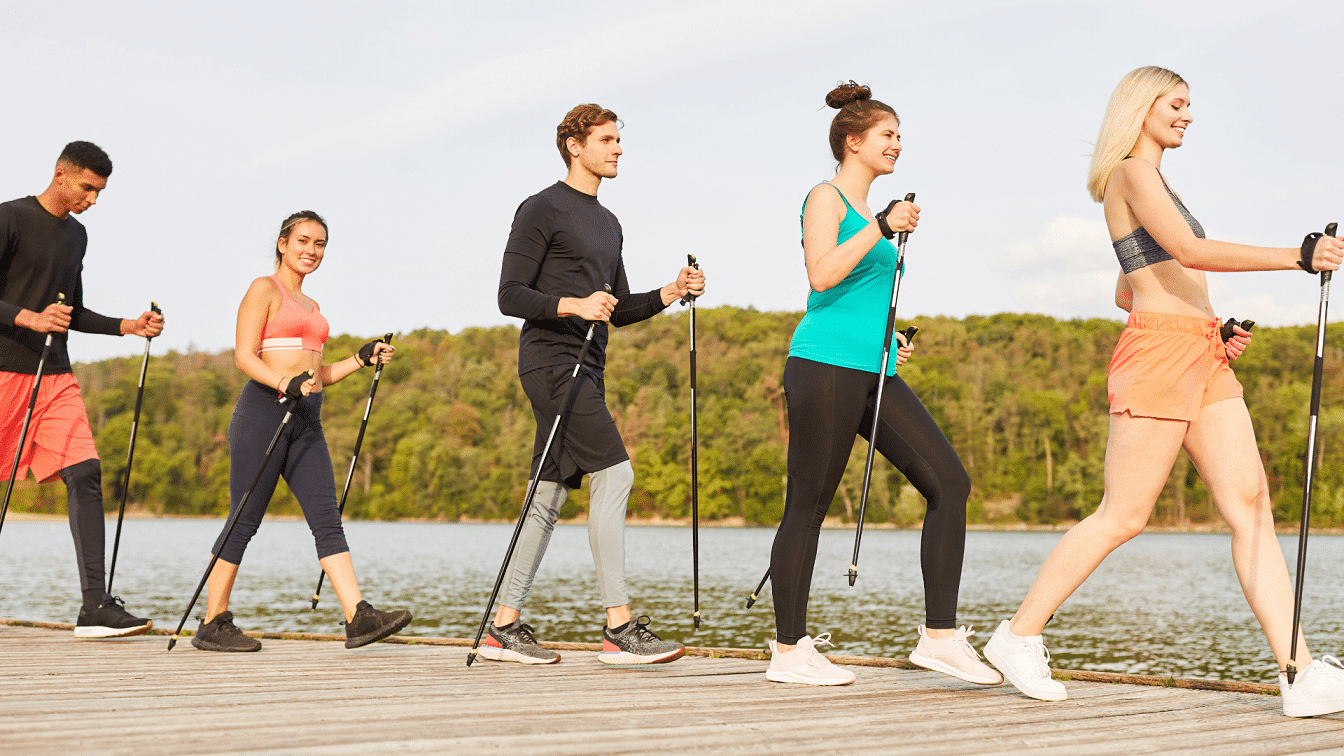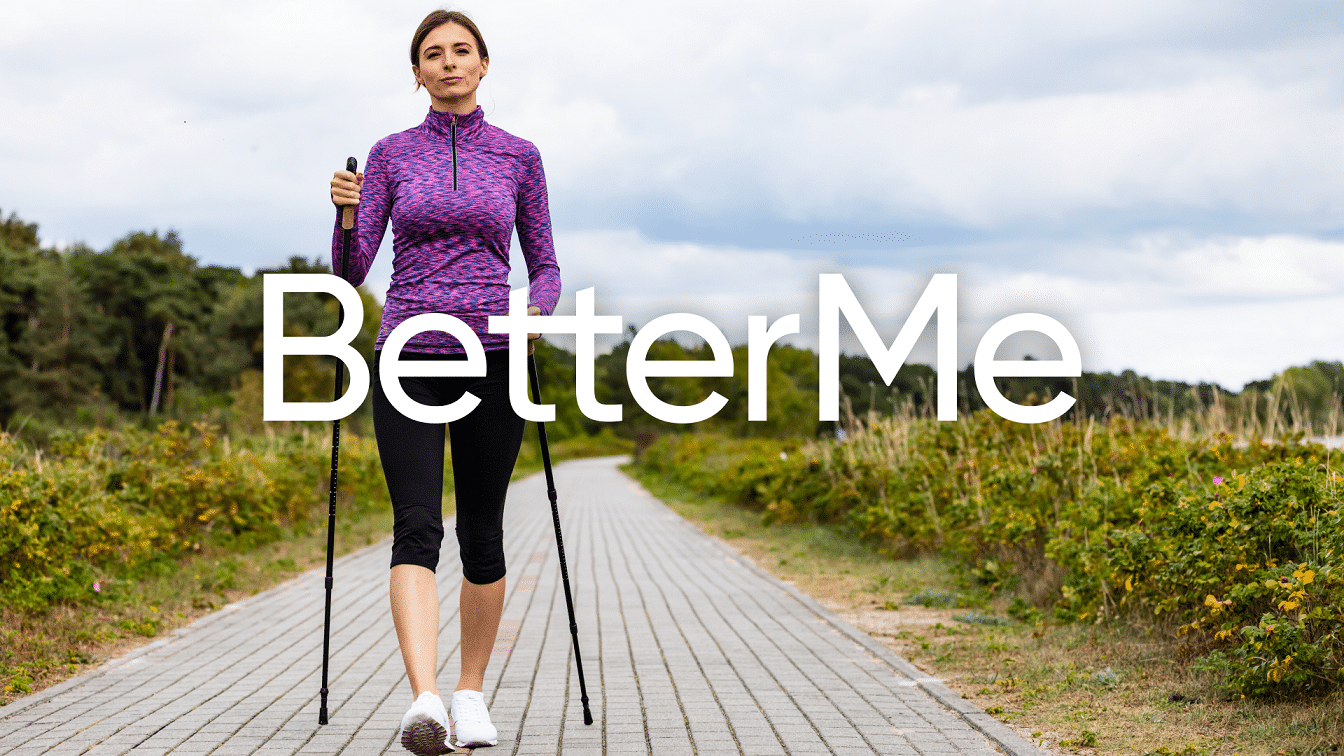There are so many forms of exercise programs in the world. The simplest of all and that most people prefer is walking. Although it helps burn calories, it may not burn as many calories as you would want. Luckily, there is an advanced form of walking known as Nordic walking that burns more calories. It involves walking with poles, which helps target more muscle groups. However, it comes with its pros and cons. Join us as we explore the Nordic walking disadvantages.
What Is Nordic Walking?
Nordic walking is a full-body form of walking where you propel yourself using a pair of long poles (4). Some people compare this to cross-country skiing, minus the skis and outfits. However, the technique of these two exercises highly differ.
Similarly, Nordic walking is quite similar to brisk walking; the only difference is that in Nordic walking, an individual has to use specially designed poles. These poles add an advantage of actively involving your upper body and arms, similar to when cross-country skiing using the diagonal technique (1).
This exercise program incorporates Nordic poles due to their added advantage in the program. For example, experts acknowledge that these poles may be a sign of reducing pain ratings when walking and, therefore, can be effective with pain management (1).
Generally, Nordic walking is beneficial, fun, safe, and easy to learn. So, you can incorporate it into your lifestyle as an exercise program. However, remember to consult before making such changes.
Nordic Walking Advantages
Before we look at the disadvantages of Nordic workouts, it is essential to understand what this exercise brings to the table. Nordic walking has been found to have the following benefits:
Providing A Thorough Workout
According to Health Harvard, this exercise combines cardiovascular exercise with a vigorous muscle workout, good for your legs, arms, shoulders, and core (2). When you are walking with these poles, the rationale is that you activate 90% of your muscles, unlike without them, where the activation level is 50% (2).
Increasing Calorie Burning
Perhaps you are looking for an exercise program to burn more calories for weight loss? Look no further! Numerous studies confirm that Nordic exercise helps you burn more calories than regular walking (2). In addition, it is believed to increase calorie burning from regular burning of 18% to 67% (2).
Read More: Does Walking Help Period Cramps? Reasons You Should Consider Walking For Menstrual Pain Relief
Reducing Bad Cholesterol Levels
Nordic walking has also been linked to reduced LDL “bad” cholesterol and increased HDL “good” cholesterol in your body (2). Studies also reveal that it reduces your waist circumference, triglyceride levels, anxiety, depression, and chronic pain (2). With these, experts reveal you acquire more endurance, cardiovascular fitness, flexibility, muscle strength, walking distance, and quality of life (2).
Increasing Stability
Most people who have never understood the purpose of walking sticks, so they call them, believe they are merely for extra support. To some extent, it is true because these poles also help in providing support.
However, these walking sticks for balance play a crucial role in the exercise as they help in targeting different body muscles. For example, it targets your back which helps in improving posture and stability.
Additionally, when Nordic walking, you are expected to maintain proper form and technique, which helps build stability and balance (2).
Increasing The Fun Meter
Lest we forget how fun this activity is, mainly when performed in groups. It is an excellent social activity that you can do with your friends or colleagues as part of team building.
If you’ve mustered up the courage to crush your weight loss goal, let Betterme take the sting out of this demanding process. Our app will help you restructure your habits, remold your life and crank up your fitness results!
Nordic Walking Disadvantages
Despite having the following benefits, this exercise program also has several cons. Understanding the disadvantages is imperative because it helps you weigh whether this activity is worth it or not.
Now, here is where most people go wrong. Most individuals never take time to research these disadvantages. Instead, they rely on what one says. Such an approach is deemed inaccurate because most people’s perceptions are biased or misconceptions.
So, take your time and research for better results. Luckily, we have done the research and will save you that hustle and bustle by giving you a detailed overview of Nordic walking disadvantages.
This activity’s disadvantages are as follows:
Mastering The Technique Takes Time
Contrary to what most people think, Nordic walking is not only about walking with poles. Yes, it is straightforward, but a lot comes into play, especially when you want to sneak in some workout. So, you will have to learn the difference between walking with poles for fun and training.
For a thorough workout, you will have to learn how to use the poles to gain propulsion without injuring your wrist joints (3). Unfortunately, that is not the case for many people because they tend to hold the poles too tightly.
Again, most people forget to lean forward with every step, which disorients their entire form and posture. Another mistake most people make during Nordic walking is bending their elbows when pushing the poles backward.
You are required to straighten your arms when pushing your poles backward because they work your back and stomach. So, you end up working for various significant groups in your back, abdomen, and legs. Again, you have to remember that there are different forms of Nordic walking. They include (2):
-
Double Poling
This technique entails planting both poles symmetrically before you and pulling yourself forward as you take a few steps. So, it would help if you remembered to double pole and take at least three steps ahead.
-
Single Poling
As the name suggests, this technique involves taking a step with only one leg. However, there is a twist. As you bring one leg forward, you must bring your opposite or the same-side arm. So, your pole and foot must be striking and propelling at the same time (3).
The only difference is how you choose to move your arms. If you just started this program, you are advised to follow the same-side arm for better movement coordination. With time, and after learning proper coordination and building up speed, you can try with the alternating limbs. It means you choose an opposite arm.
Most people often get confused when following the single poling technique. So, you are advised to take your time to master the correct technique before giving it a try. If not, you can ask your trainer to teach you how to do it, as this seems like a faster approach to mastering the technique.
By looking at these, you can tell that it will take time to learn the correct form of both techniques. Because of this, most people may prefer to use other exercise programs such as jogging, running, or brisk walking, which happen to be less complicated.
Expensive
If you want to reap the most from this exercise, you must use good poles (3). So you must invest and get yourself good poles. Unfortunately, some people may not be able to afford the poles, so some try to use the ordinary walking poles.
But the question is, can you use ordinary walking poles for Nordic? Fitness experts do not think so. They reveal that although they are both used for walking purposes, Nordic walking poles fit this activity best.
They continue to state that these poles help with proper propulsion and increase in stride. Unlike the ordinary walking or trekking poles, the Nordic poles also plant at an appropriate angle for the Nordic walkers (3).
You can always ask for help from a specialist if you want help purchasing Nordic walking poles. They are way shorter than ski poles, and on their handles, they have unique straps resembling fingerless gloves where you are required to place your hands. So, when you go to buy Nordic walking poles, make sure they:
- Have adequate length
- Have a comfortable handle, where your hand fits perfectly
- Have a comfortable strap that is neither squeezing your hand nor dangling
- Suit your terrain/geographic location (if you are Nordic walking on hard terrain, opt for rubber poles; you can opt for metal or plastic poles if you walk on ice, tropic regions, or snow)
- Have fixed yet perfect height or adjustable ones
Health Harvard reveals that the prices of an excellent walking pole range from $20 to $200 for a pair (1). On top of that, you also have to wear the right shoes. The best ones have a cushioning sole to help reduce stress and tension on the lower limbs and spine joints. But, again, feel free to talk to a specialist about the best shoes to purchase.
Read More: A 21-Day Walking Plan For Fat Loss
Not Everybody’s Cup Of Tea
Although Nordic walking seems easy to perform, it requires some training, as we discussed earlier. Unfortunately, it is also not suitable for everyone, but not because of the training aspect. Instead, it is because of medical conditions.
Some medical conditions may be triggered or worsened by this exercise, so you need to get your doctor’s go-ahead before starting this exercise program. In addition, health experts suggest you reach out to your doctor before trying Nordic walking or any other exercise program if you experience the following (5):
- Fever. Although most people may not consider it a big deal, a fever indicates your body is battling something more severe like an infection. So, during this period, you are not supposed to deal with stress from exercise. You may overheat and become dehydrated because your body fluids decrease whenever you have a fever (5).
- Flu. With flu comes a fever and as we have seen from above, exercising with a fever is not ideal. So, take some time off and rest.
- Recent Asthma Flare-up. You also need to avoid this exercise if you recently had a flare-up from a respiratory infection. You need to skip your workout and rest as instructed by your doctor. When your asthma is well-controlled, your doctor may recommend low to moderate intensity exercises if they are safe for you (5).
- Recent Concussion. You should never perform any exercise routine after suffering a concussion, even if you feel okay. Health experts describe a concussion as a traumatic brain injury, meaning you need ample time for your brain to heal properly. So, take some time off exercise because you risk swelling and experiencing potential catastrophic damage (5).
- Old Injury. You also need to consult with your doctor before Nordic walking if you have an old injury acting out (5). It could be a bad knee, an injury on your shin, arm, or elsewhere. This is never a good sign because it may mean the wound never healed. It means you have to seek immediate medical attention.
- Extreme Fatigue. You may experience muscle soreness or fatigue sensations after a day or two of Nordic walking. However, if the fatigue is intense and you can hardly function as required, you need to talk to your doctor immediately. Persistent and extreme fatigue may indicate an underlying condition.
- Sharp Pain. If you experience sharp pain anywhere after your last workout, stop and contact your doctor.
- Back Pain. Your back may hurt, especially if you do not maintain the correct form required for the exercise. Take it easy for the next few days. Do not do any activity that may make the pain worse, such as bending or twisting. If the pain persists, get help immediately.
- Pregnant. It would help if you talked to your doctor about safe exercise in pregnancy. Usually, most doctors do not recommend contact sports or activities due to the increased risk of injury. Such activities include water skiing, horseback riding, and bicycling. Instead, they recommend low or moderate activities that do not strain pregnant women (5). Even so, it would help if you still talked to your doctor to learn of a low or moderate exercise program that meets your needs and fits in your fitness level.
Extra Luggage
Even if they do not weigh much, they make up for extra luggage that can be uncomfortable to carry. Many people may agree that the most they want to carry, especially on their hands, when walking or hiking is nothing.
So, the thought of carrying these poles around may be mind-boggling. But, again, it may annoy some people to keep using these poles during long stretches or after they experience fatigue. Sadly, you cannot change this because they are the most critical aspect of this exercise program.
Reasons why BetterMe is a safe bet: a wide range of calorie-blasting workouts, finger-licking recipes, 24/7 support, challenges that’ll keep you on your best game, and that just scratches the surface! Start using our app and watch the magic happen.
Uncomfortable For Some
Nordic walking involves a lot of arm swinging, which may not sit well with some people. But, unfortunately, little can be done to change this because it is the correct approach. So, although you have to do it, some people may be doing it with a heavy heart because of the discomfort. If it were to become unbearable, you would find such individuals changing their exercise programs.
For others, the discomfort is experienced in their hands. Therefore, if your pole does not have a comfortable handle, your Nordic walking experience may not be pleasant. This is the reason you are asked to invest in an excellent Nordic walking pole.
Potential Trip Hazard
A trip occurs when you catch your foot on something, making you stumble or fall. For example, you may catch your foot in the walking poles and end up stumbling or falling. This is dangerous, especially if you are walking on a hard surface.
However, you can minimize the risk of these trips by paying attention to your movement. As mentioned above, there are different types of Nordic walking techniques. Pay attention to the method you chose, and make sure you coordinate your arms and legs as expected.
Similarly, focus on your path. You do not necessarily have to trip because of coordination. You may also trip because of where or what you step on your path. So be alert and on the lookout to minimize potential trips.
Make Other Activities Harder
Although not impossible, Nordic walking may make other activities a problem to accomplish, for example, hydrating. As we all know, you are required to hydrate before, during, and after your workouts (5).
However, drinking water during the Nordic walking activity can be a challenge because you are walking with poles fixed to your hands. Although they are not glued to the poles, any slight change or movement can lack coordination and throw you off your Nordic walking technique.
Besides hydrating, other activities that prove problematic are blowing your nose, using your phone to access Google maps, eating a snack, or accessing your phone. The only way to perform these activities is by making a stop.
We all know how tempted you become to stop for longer, especially if you are experiencing fatigue or have blisters. Longer breaks may throw your body off the calorie-burning process following the decreased intensity. So, try to make your in-between breaks a little bit shorter.
Can You Still Start A Nordic Walking Exercise Routine?
Talk to your doctor if you are still interested in this activity despite learning its cons (3). They may either equip you with some tips or discourage you from upholding the activity. Whatever they decide, be sure to stick to that decision because these professionals have the best interest at heart.
The Bottom Line
Although Nordic walking is an excellent exercise option, it does have some cons that may hinder some people from upholding it. Some of the disadvantages of Nordic walking include the costly expenses, risk of tripping, complex and time-consuming techniques, discomfort, and interruption of other simple activities. Be sure to go through this list of Nordic walking disadvantages with an expert if you are still interested in this activity.
DISCLAIMER:
This article is intended for general informational purposes only and does not serve to address individual circumstances. It is not a substitute for professional advice or help and should not be relied on for making any kind of decision-making. Any action taken as a direct or indirect result of the information in this article is entirely at your own risk and is your sole responsibility.
BetterMe, its content staff, and its medical advisors accept no responsibility for inaccuracies, errors, misstatements, inconsistencies, or omissions and specifically disclaim any liability, loss or risk, personal, professional or otherwise, which may be incurred as a consequence, directly or indirectly, of the use and/or application of any content.
You should always seek the advice of your physician or other qualified health provider with any questions you may have regarding a medical condition or your specific situation. Never disregard professional medical advice or delay seeking it because of BetterMe content. If you suspect or think you may have a medical emergency, call your doctor.
SOURCES:
- Acute effects of walking with Nordic poles in persons with mild to moderate low-back pain (2016, ncbi.nlm.nih.gov)
- Fitness trend: Nordic walking (2019, health.harvard.edu)
- Health benefits of Nordic walking: a systematic review (2013, pubmed.ncbi.nlm.nih.gov)
- Is it worth it? Nordic walking (2015, theguardian.com)
- When Not to Exercise (2010, webmd.com)

















